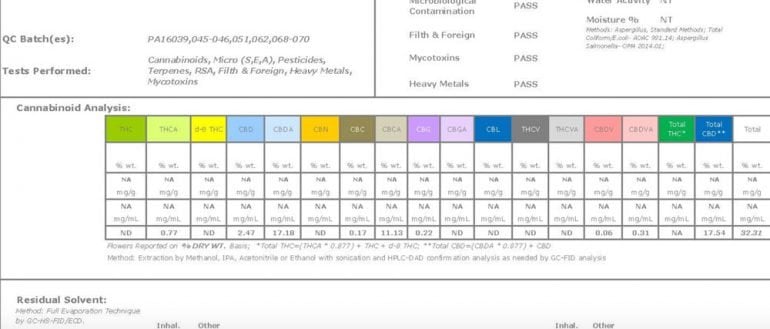Rather than seeing a decline in sales as so many industries have this year, Cannabidiol (CBD) is continuing to grow more with every passing day. That means there are more CBD products on the shelves than ever, which can be a little overwhelming for consumers. One of the only reliable ways to determine if a product is a good fit is to examine its CBD Certificate of Analysis (COA).
A COA is a document that shows all of the lab tests which have been performed on a product. It can, however, get a little technical to navigate, which is why we’re going to show you how to read and analyze a COA today.
While branding and aesthetics are nice, how can you know if the product you’ve chosen is reliable or safe?
Where to find & access COAs
Most COAs, unfortunately, aren’t incorporated into product labels. This means you have to know where to look for a COA. This will usually be on a brand’s website. It can be located in one of several places including on the product page itself, on a ‘About’ or ‘Educate’ page, or in its own ‘Lab Results’ section.
Lab results displayed online generally vary as one of two formats. You either get producers that batch test frequently throughout the year (ideal), or find one result per product rather than a few. Batch testing dates are generally listed on a COA page. Other COA pages may ask you to input a lot or batch number before allowing you to access your results. Most lot numbers are found on the bottom of CBD products.
Product Review: CBDfx Sublingual Strips
Some products may also have QR codes built into the packaging that you can scan with your phone. Scanning the code should then take you to the brand’s test results page.
Product Review: Bloom Farms Relieve CBD Tincture
Understanding COAs
Potency
The first section you’ll probably see on most COAs is ‘Potency’. Potency is expressed as a percentage of weight and refers to the strength of the compounds found in your cannabis. In this case it’s primarily used to refer to the potency of your main cannabinoids, usually Tetrahydrocannabinol (THC) or CBD.
Cannabinoid concentration is measured in milligrams (mg). You can determine how much of a cannabinoid is in your CBD by viewing the column titled “Conc” (short for concentration). You may also see the term ‘ND’, which means not detected. This means a compound exists in levels too small to be measured. Another term that denotes this is ‘BLQ’ (below limit of quantification).
Also Read: These are the three biggest misconceptions about CBD.
Beneath the section on potency is usually a table showing cannabinoid content. This table contains a few columns that basically tells you exactly which cannabinoids are in your CBD.
Cannabinoid Content
On the left hand side you’ll see a column labeled ‘Analyte’. This refers to the cannabinoid being measured. You’ll then find a column labeled as ‘LOQ’. LOQ means ‘limit of quantification’, which is the smallest unit of a compound that can be measured.
A good way to think of this is to view concentration levels compared to LOQ levels. Let’s say you’re looking at a full spectrum CBD tincture whose label claims to be “Cannabigerol (CBG) rich”. If the CBG concentration value listed is very close to the LOQ that means you have little to no CBG in the product.
It’s also important to keep in mind these results that don’t take decarboxylation into account. Decarboxylation is the process by which ‘raw’ acid forms of cannabinoids such as CBDA are converted into CBD. The reason why labs don’t take this into account is because decarboxylation happens when heat is applied, and since most labs don’t heat cannabinoids they can only provide estimates of how raw acid cannabinoids will convert.
Product Review: Ananda Hemp Broad Spectrum CBD Oil
Types of tests
Your CBD can be subjected to many different types of tests that appear on a certificate of analysis. These include:
Pesticide tests
These tests ensure your CBD flower was grown without the use of pesticides.
Heavy metals tests
Cannabis, especially hemp, can be a bioaccumulator. That’s why it’s crucial you only purchase products that have heavy metal testing available.
Microbial tests
A microbial is a microorganism such as a bacteria. The presence of microbial agents in CBD and cannabis can have a range of adverse health effects.
Mycotoxin tests
Mycotoxins are fungi-produced compounds. Like microbial agents mycotoxins can also cause illness and disease in humans.
Water content/moisture tests
Trimmed CBD flower undergoes a curing process to ensure it’s free of any water or mold. Water content and moisture tests ensure your final product has sufficiently dried and cured.
Residual solvent tests
A solvent is a substance that dissolves another. CBD extraction often relies on the use of industrial solvents like Butane, which is why you should opt for products with residual solvent tests whenever possible.
Terpene tests
Terpenes are aromatic compounds found within cannabis and other plants that give them their unique effects. Terpenes are also highly volatile, meaning they dissolve quickly.
Terpene testing isn’t COA-mandated. But the presence of terpene tests on a certificate of analysis is generally a good indicator that a product is fresh. Terpenes also have their own therapeutic benefits and work synergistically with cannabinoids such as CBD.
Also Read: On the SIBO Diet? Avoid these five foods
In other words: use terpene rich products for the best CBD experience possible.
Terpene tests will have an ‘Analyte’ column on the far left as well as a column denoting concentration. The Analyte column will show all of the various terpenes found in the sample.
How to read CBD Certificate of Analysis results
Most tests, such as pesticides and heavy metals, will have acceptable limits for each compound listed on the CBD Certificate of Analysis. They’re designated by groups like the FDA and refer to the levels of compounds ingested that are safe.
To read a test result you’ll need to cross reference a compound’s potency with its acceptable limit. If a substance’s potency is under the recommended limit, great! That test passes. If a product contains a compound in amounts greater than the acceptable limits (or doesn’t list them at all) you might want to opt for another product.
Some tests will have a ‘passing’ grade while others may require you to manually view results. You may also find text like this: “None of the residual solvents tested found above the limit of quantitation in the sample,” which is effectively a passing grade.
Also Read: Here’s how long your CBD will last
Final tips on understanding a CBD Certificate of Analysis
Do not buy products without lab test results as there’s no way to ensure their safety. If you don’t see a CBD certificate of analysis, then steer clear of that product and brand. There’s a good chance that CBD is not high quality.
Make sure all lab test results have been performed by an accredited third party—not the brand itself. You should see this information available in the header section of most reports.
Opt for products that have thorough, up to date labs whenever possible. Lab results should ideally be less than a year old.

Janelle Lassalle is a writer and content creator that specializes in cannabis. She’s also an insanely passionate advocate and expert in all things CBD. You can find her work featured in a variety of publications such as Healthline, The Huffington Post, Leafly, Forbes, and High Times. Check out her portfolio, or follow her on Instagram @jenkhari.





